More than 80% of worldwide panelists have said data is affirmatively important to the deployment of their advertising and marketing efforts, and even more — a whopping 92.2% — said it’s likely to play an increasingly important role in the future. That’s according to a recent report from Winterberry Group, The Global Review of Data-Driven Marketing and Advertising.
The increase in connected devices and the rapid rise of Internet users, combined with the fact that many offline services have now moved online, means there is more data on the Internet now than ever before, and with the rise of the Internet of Things (IoT), the amount of data circling the Internet is set to skyrocket.
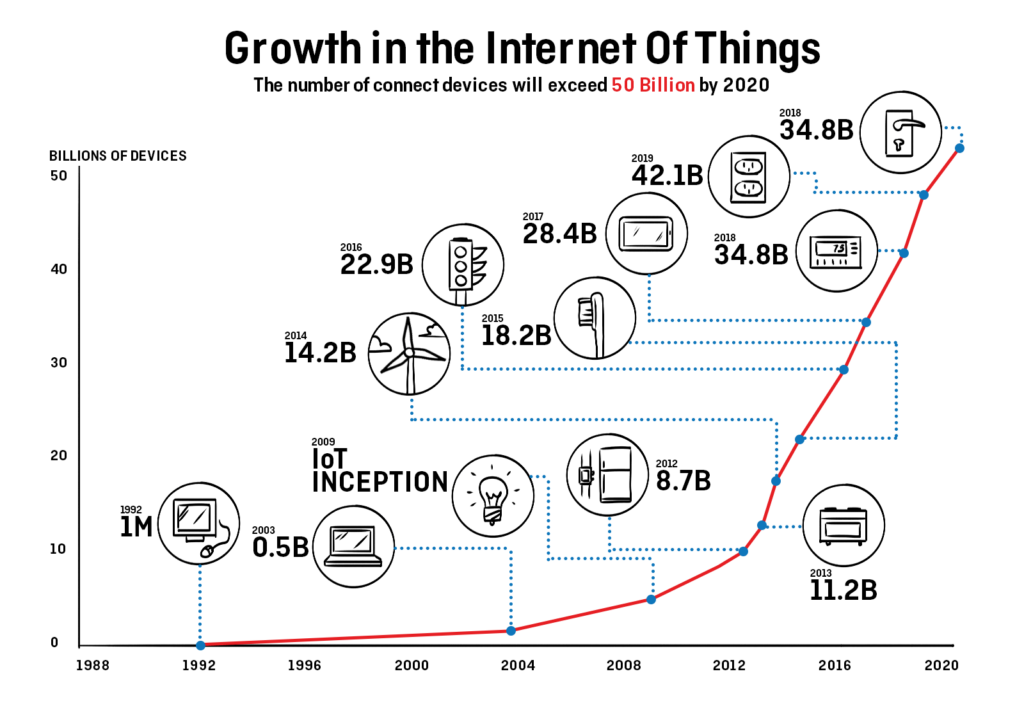
So with all this valuable data floating around, the need to centralize large amounts of information from different sources and turn it all into results has become evident.
That’s where a data-management platform (DMP) comes in.
What is a Data-Management Platform (DMP)?
In short, a data-management platform is a technology platform that collects data from a range of different sources, classifies and categorizes it, puts it into different groups (segments), and then uses those segments to achieve certain goals.
What Types of Data Does a Data-Management Platform Collect?
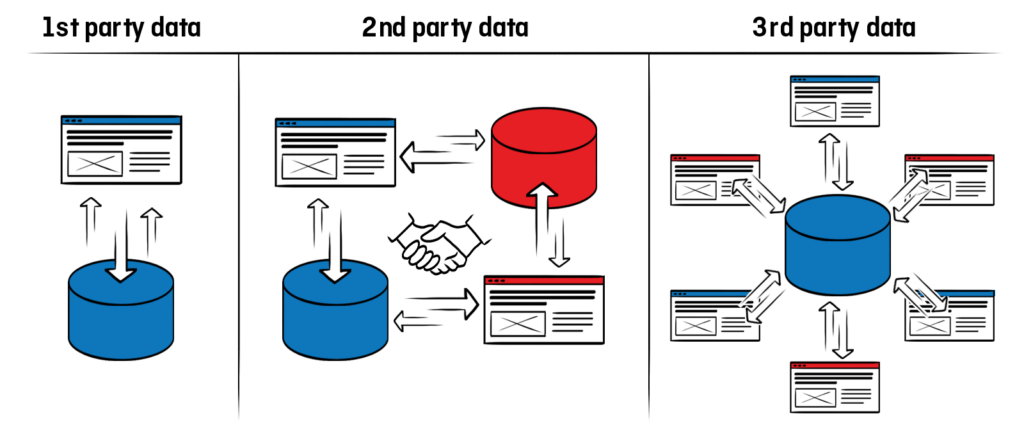
First-party data is information gathered straight from the user or customer. Data from:
- Web and mobile analytics tools.
- Customer Relationship Management (CRM) systems.
- Transactional systems.
- Subscriptions and newsletter signups.
Second-party data is information initially collected in the form of first-party data, then passed on to another company through a partnership agreement, e.g.:
- Ad-serving data.
- Audience information.
Third-party data is collected from a range of different sources and sold to companies to be used for audience targeting and analysis.
Who Needs A DMP And Why?
In an effort to increase marketing ROI, marketers, advertisers, and agencies have increased the number of the campaigns across many channels. The result is poor ROI caused by low engagement.
In order to solve this ever-growing problem, companies need to stop trying to reach more people and start trying the reach more of the right people, and a DMP helps them do just that.
“Behaviorally targeted ads are more than twice as valuable and twice as effective as non-targeted online ads.” – Network Advertising Initiative.
A data-management platform can be used by advertisers, marketers, and agencies to optimize their media-buying processes. However, even companies that don’t operate directly in the online advertising space can still greatly benefit from a data-management platform.
Essentially, a DMP can benefit those who:
- Manage online advertising campaigns that involve connecting with other ad-tech platforms (e.g. ad networks, demand-side platforms, ad exchanges, and supply-side platforms, etc).
- Want to increase conversion rates, improve the user experience on their website or apps, and increase brand recognition.
- Want to lower advertising costs and improve campaign ROI across display, mobile, video, and social.
- Want to personalize messages and content shown to customers and potential customers through advertising, remarketing, and other brand interactions (e.g. on the brand’s website and email newsletters) to increase engagement.
- Want to learn more about their existing users and customers to help shape product offers and services.
- Want to connect offline data with online data to create a Single Customer View (SCV).
So now that we’ve had a look at some of the general ways a DMP can benefit companies, it’s time to go a bit deeper and see how a DMP can be beneficial in specific ways.
A DMP For Publishers
Data-management platforms are not generally associated with publishers (website owners); however, they can provide just as many advantages to publishers as they do to advertisers, marketers, and agencies.
So, what can publishers do with a data-management platform?
Monetize The Data
Publishers, especially those attracting large volumes of traffic, can monetize their traffic by segmenting and selling valuable audience data to other companies. These companies could either be online advertisers or other websites wanting to target specific audiences.
Let’s look at an example.
Say there is a very popular music website (publisher) that offers streaming options comprising of both a free service (up to two hours of free music streaming per week) and a premium service (an unlimited amount of music streaming).
The music site could segment its visitors into a range of audiences, which could look something like this:
Segment 1
Visitors who live in the New York area and stream up to two hours of music per week.
Segment 2
Visitors who have a premium account, aged between 18-25, and visit the site at least once a week.
Segment 3
Visitors who only use mobile devices to view the website and do not stream music.
The music site can monetize these segments in two ways:
1. Partnership
The publisher can set up a direct and exclusive partnership with another website (e.g. a site that wants to target people living in the New York area that listen to the music online) so they can display their ads to that particular audience. The data used by the second website then becomes second-party data.
2. Data Broker
The publisher could also just sell the segments to an existing data broker. However, compared to the partnership option, this monetization process is much less transparent. The publisher also loses its independence, as it is the data broker who decides which segments of data are shared and what kinds of segments are created from the publisher’s visitors.
Use The Data
Publishers also have the option of using their data to generate and increase revenue of their own products and services via upselling.
According to research from one of Forrester’s analysts, product recommendations via upselling and cross-selling increase sales by 10% – 30% on average.

But what does this look like in action?
Let’s look at this using the same example as before with the music site.
So, for example, they could create an email campaign whereby they send a series of emails to non-paying, but highly engaged visitors who stream more than one hour of music per week (Segment 1), encouraging them to subscribe to the premium service offering an unlimited amount of music to stream each week.
As these visitors constantly show keen interest in the content on the site, they are more likely to subscribe to the premium service than visitors who only visit the site, like the users in Segment 3.
A DMP For Advertisers and Marketers
Predominantly, a DMP will benefit advertisers the most due to the numerous avenues they can explore with data.
Here are a few main ways advertisers can benefit from a data-management platform:
1) Personalized Remarketing
Remarketing, also known as retargeting, is a highly powerful advertising and marketing technique that has been used by advertisers, companies, and e-commerce stores to increase revenues for many years, and while the traditional and somewhat basic methods of remarketing are effective, they can be greatly improved with personalized remarketing.
By collecting first-party data about visitors who visit a site and enriching that information with third-party data and offline data, companies can run personalized remarketing campaigns to target specific audiences.
Here are a couple examples of how personalized remarketing can be applied to different areas:
Shopping Cart Abandonment: Companies, particularly e-commerce sites, can get back some of the 50% – 70% of sales lost through cart abandonment by utilizing personalized remarketing. Companies and e-commerce stores can remarket the abandoned products and services to visitors via ads and email campaigns.
Finished Product and Service Trials: There is a huge opportunity to convert users who have trialed products and services but didn’t convert. Creating a number of specific segments (e.g. users who didn’t subscribe to services worth varying amounts) and then targeting them with specific messages can help increase subscription rates.
While a DMP can help you personalize remarketing messages, it can also help you personalize other messages as well. A classic example is personalized and dynamic content served on your website. By utilizing the data stored in your DMP, you can personalize the message users view on your website to improve the overall user experience, but more importantly, increase conversions and revenue.
2) Data-Driven Media Buying
With the effectiveness of banner ads declining and the popularity of ad blockers increasing, the need to display relevant ads to the right user has never been more important.
By collecting and utilizing first-, second-, and third-party data, advertisers can increase their chances of displaying relevant ads to the right, and often highly engaged, audiences.
3) Analytics
Analytics has long played a crucial role in understanding how users behave on websites, but the analytics of today is used to evaluate more than just pageviews and visits.
By collecting and analyzing data from a range of sources, advertisers can discover new trends, identify and fix conversion drop-offs, and better understand their audience and behavior.
Analyzing the data also helps create customer segments, which, in turn, will help increase sales. This can be achieved by evaluating past purchases, what visitors click on, their preferences, and how well they respond to certain offers.
4) Single Customer View (SCV)
Creating a single customer view (SCV) allows advertisers and marketers to directly identify their users, thus allowing them to get a better and deeper understanding of their users, their behavior, and how they interact with their brand.
A SCV is achieved by tracking customers across multiple devices. As consumers use a number of devices to interact with a brand, it is vital that all of these interactions are recorded and assigned to the same customer profile.
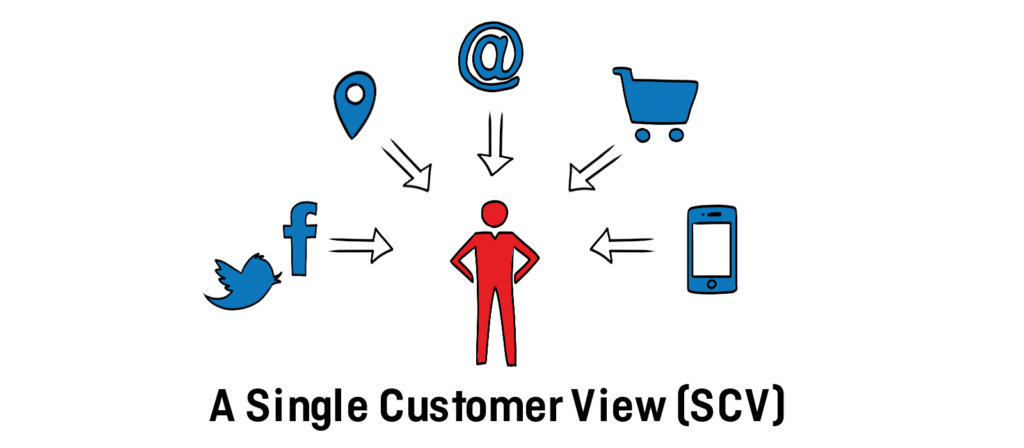
However, in a world where consumers use smartphones, tablets, and desktops to view various websites and social-media networks, tracking them is, well, tricky, but there is a solution: a Universal ID.
A Universal ID is really a combination of many IDs taken from many different devices and channels.
For example, let’s say that you are on your desktop computer and you click on a link that takes you to an article on the New York Times website. A DMP that has its tracker on nytimes.com sets a third-party cookie on your browser, which identifies your browser on your desktop computer.
Now, let’s say that in the evening you turn on your tablet and use the native New York Times app to read other articles. As cookies cannot pass from one device (e.g. desktop computer) to another (e.g. tablet), you are identified by a different ID on your tablet. However, the DMP may be able to match these two IDs together in two ways:
By recognizing a unified user ID: If you have ever logged into your browser or the New York Times site with the same username as on your tablet, then the DMP can match the unified user IDs used to log in.
By using probabilistic ID: This process analyzes a wide range of data to identify, with certain probability, that the desktop user is the same person as the tablet user.
How Do DMPs Achieve All Of This?
While different DMPs will offer slightly different features and perform slightly different functions, all DMPs inherently perform three main processes: collection, segmentation, and activation.
Collecting The Data
The primary function of a data-management platform is collection.
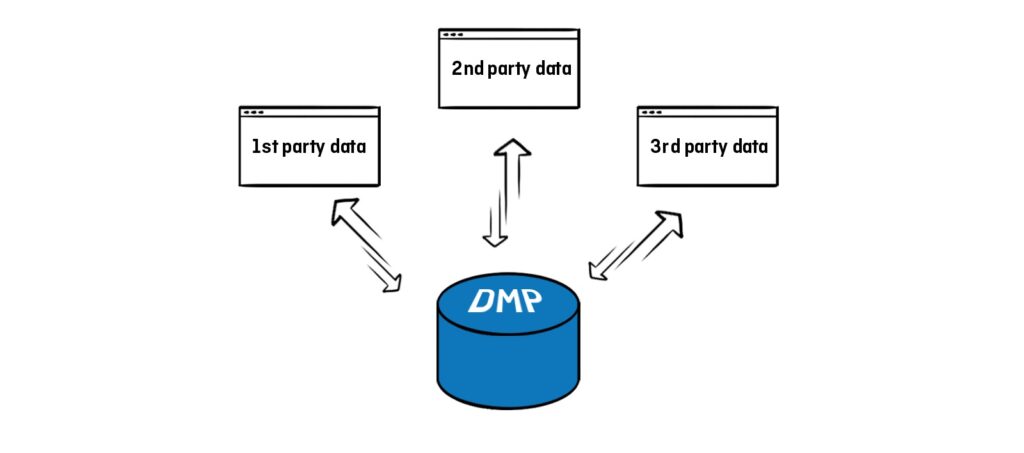
Data, especially these days, comes from a range of different sources, which include:
Online Data Sources
- Customer Relationship Management (CRM) platforms.
- Marketing-automation platforms.
- Email-marketing software.
- Analytics platforms.
- Tag-management systems (TMS).
- Websites and mobile apps.
- Second- and third-party sources.
Offline Data Sources
- Retail transactions from in-store purchases.
- Loyalty-card data.
- Contact details collected at events, conferences, expos, etc.
The Data Collection Process
The actual collection process for each data source varies.
For first-party online data, the collection process usually involves placing a tag (e.g. an analytics tag) on your website that will then send all the data to your DMP. You should, of course, set up your DMP to import data from your CRM tools, but be sure to add offline first-party data (e.g. contact details from someone at an expo) into your CRM to ensure your DMP collects both online and offline first-party data.
For all other types of data, e.g. second- and third-party data and offline data, it’s a matter of integrating your DMP with your data suppliers, e.g. via cookie syncing.
Segmenting The Data
Once the data has been collected from the various sources, it is then time for segmenting.
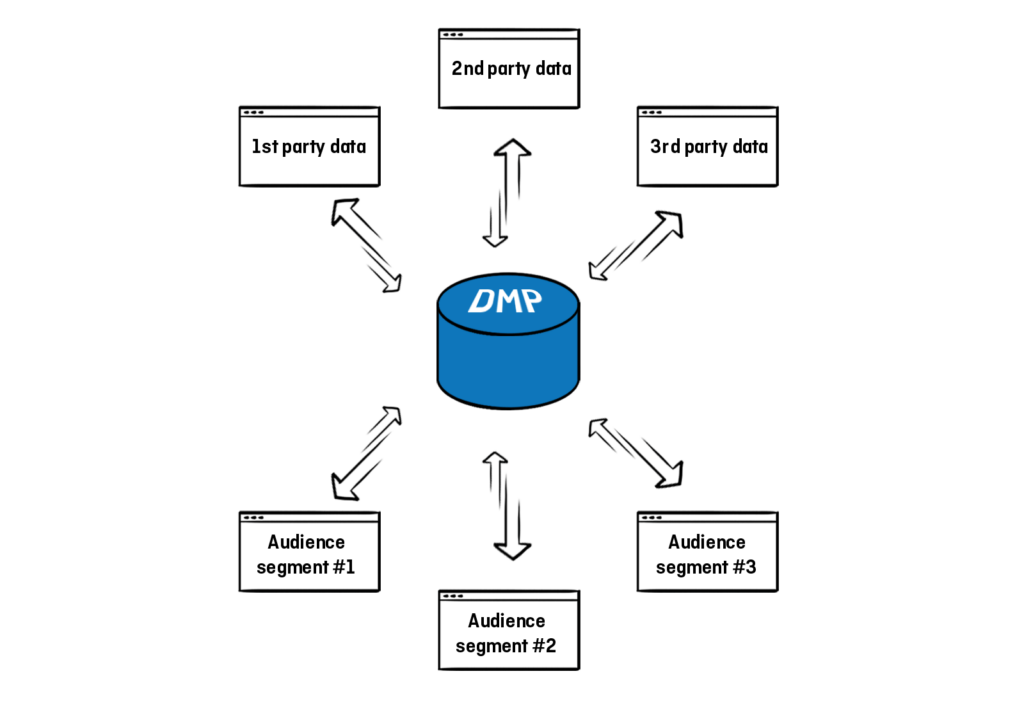
Segmenting allows you to group certain pieces of data together based on similarities and then use the segments to target different audiences.
For example, you could create a segment based on user demographic and behavior, like Segment 1 from the example above (people who live in New York who stream up to 2 hours of music per week.)
You could then use this segmented audience and target certain messages directly to those users. This message could be anything, as long as it relates to them – for example, you could show them ads promoting discounts on restaurants in New York.
You can create just about any number of segments, but it’s important that you create segments that related to your business and the goals you want to achieve.
Another topic related to data segmentation is data taxonomies.
When you create data taxonomies, you are essentially creating data categories.
Let’s take a look at how an e-commerce store and an airline might create data taxonomies.

It’s important to note that the data taxonomies you create need to be the same across all your different systems to ensure they all agree with each other. Many argue that data taxonomy is merely a mechanism for organizing data and getting agreement on the meaning of terminology. Taxonomy is a critical part of Master Data Management (MDM).
Activating the Data
Once the data has been collected and segmented, it is then activated.
In this process, the DMP takes the data and puts it to work.
A few specific examples about how to activate the data have been mentioned previously, so let’s take a look at an example of how advertisers, marketers, and agencies can active data when buying online media:
Use Data on Other Advertising Technology Platforms
You can use the data about your visitors and audience on other advertising-technology platforms. Typically, this is achieved by syncing the cookies with demand-side platforms (DSPs), supply-side platforms (SSPs), ad exchanges, ad servers, dynamic creatives engines, etc. Once you have synced cookies with the ad-tech platforms, it is simply a matter of exporting a defined audience (segment) to these platforms.
An alternative to cookie syncing is data onboarding. This process works by taking offline data (e.g. residential mail addresses, email addresses, etc.) and transforming it into online cookies via an onboarding partner such as LiveRamp or iBehavior. Onboarding partners such as these have extensive data sets that can help you find the online cookies that correspond to your offline data (e.g. an email address collected during a trade show).
The ability to use your data across other technology platforms enables you to serve highly relevant ads to your target audience across web and mobile.








